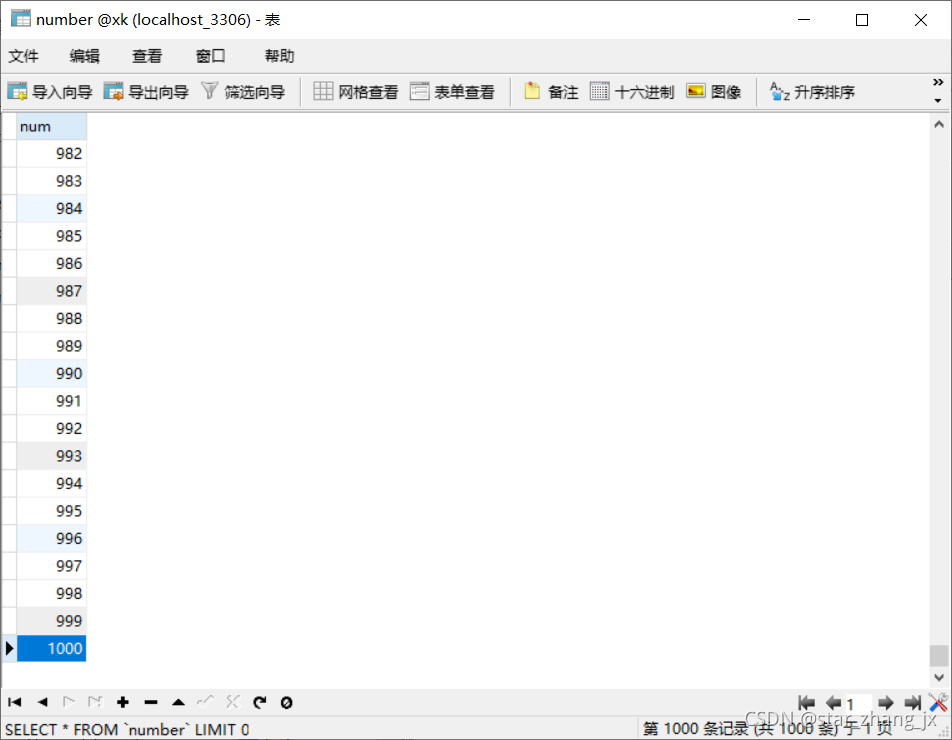问题引入
假如我们要通过JDBC实现插入大量数据,如果只是普通的插入方法要消耗大量时间,下面我们将同通过两个方面进行改进减少程序运行时间
普通方法
public void test1() {
MyConnection myConnection = new MyConnection();
Connection con = myConnection.getMyConnection();
PreparedStatement ps = null;
try {
long start = System.currentTimeMillis();
String insert = "insert into number(num) values(?);";
ps = con.prepareStatement(insert);//预编译
//插入1W条数据
for (int i = 0; i < 10000; i++) {
ps.setInt(1, (i+1));//设置属性值
ps.executeUpdate();//执行SQL语句
}
long end = System.currentTimeMillis();
System.out.println("消耗时间:"+(end-start));//23531 1W条
} catch (Exception throwables) {
throwables.printStackTrace();
} finally {
myConnection.closeAll(con, ps);//关闭连接
}
}
因为连接数据库开始的步骤基本都是死步骤,因此为了避免麻烦我就把部分代码封装进了MyConnection类中,方面获得Connection对象和断开连接
MyConnection
public class MyConnection {
private Connection con = null;
private PreparedStatement ps = null;
private ResultSet rs = null;
private String driver = "com.mysql.cj.jdbc.Driver";
private String url = "jdbc:mysql://localhost:3306/xk";
private String user = "root";
private String password = "123456";
public MyConnection() {
}
public Connection getMyConnection() {
try {
Class.forName(driver);
con = DriverManager.getConnection(url,user,password);
} catch (Exception e) {
e.printStackTrace();
} finally {
if (con != null) {
System.out.println("数据库连接成功!");
} else {
System.out.println("数据库连接失败!");
}
return con;
}
}
public void closeAll(Connection connection) {
try {
if (connection != null) connection.close();
} catch (SQLException throwables) {
throwables.printStackTrace();
}
}
public void closeAll(Connection connection, PreparedStatement preparedStatement) {
if (preparedStatement != null) {
try {
preparedStatement.close();
} catch (SQLException throwables) {
throwables.printStackTrace();
}
}
if (connection != null) {
try {
connection.close();
} catch (SQLException throwables) {
throwables.printStackTrace();
}
}
}
public void closeAll(Connection connection, PreparedStatement preparedStatement, ResultSet resultSet) {
if (resultSet != null) {
try {
resultSet.close();
} catch (SQLException throwables) {
throwables.printStackTrace();
}
}
if (preparedStatement != null) {
try {
preparedStatement.close();
} catch (SQLException throwables) {
throwables.printStackTrace();
}
}
if (connection != null) {
try {
connection.close();
} catch (SQLException throwables) {
throwables.printStackTrace();
}
}
}
}
输出结果


1W条数据插入花费23972毫秒
改进方式一
在上述方法中,我们地SQL语句是一条一条执行的
 )
)
这样子就像是我们吃瓜子时剥一个吃一个,这样不是很浪费时间(毕竟我们要一个一个放进嘴里,当瓜子多的时候就很麻烦)于是我们就可以考虑等剥到一定量的瓜子然后一起放进嘴里
解决方式:攒sql语句
1.攒SQL语句–addBatch
2.执行Batch–executeBatch
3.清空Batch–clearBatch
注意: MySql服务器默认关闭批处理的,我们需要通过一个参数,让MySQL开启批处理的支持:?rewriteBatchedStatements=true(补充在url的后面)
MyConnection2 myConnection = new MyConnection2();
Connection con = myConnection.getMyConnection();
PreparedStatement ps = null;
try {
long start = System.currentTimeMillis();
String insert = "insert into number(num) values(?)";
ps = con.prepareStatement(insert);//预编译
//插入10W条数据
for (int i = 0; i < 100000; i++) {
ps.setInt(1, (i+1));//设置属性值
//攒SQL语句
ps.addBatch();
//攒够500条执行一次
if ((i+1)%500 == 0) {
//执行SQL语句
ps.executeBatch();
//清空batch
ps.clearBatch();
}
}
long end = System.currentTimeMillis();
System.out.println("消耗时间:"+(end-start));//2480 --10W条
} catch (Exception throwables) {
throwables.printStackTrace();
} finally {
myConnection.closeAll(con, ps);//关闭连接
}
注意
这里我是通过MyConnection2获得的Connection对象,MyConnection2和MyConnection的差别

输出结果


我们可以看出明显的差距这次插入10w条数据仅用了2459毫秒也就2秒多点
你以为这就完了吗,不我们还有压榨空间!
首先我们了解一下数据库的DDL、DML
DML: (Data Manipulation Language) 数据操纵语言(用来查询与更新记录): 就是UPDATE、INSERT、DELETE。
DDL:( Data Definition Language) 数据定义语言(用来定义数据库结构):CREATE 、ALTER、DROP。
DCL: (Data Control Language)数据控制语言(用来控制数据库的访问):grant; revoke; commit; rollback; lock。
然后我们要了解什么是事务
一个或一组sql语句组成一个执行单元,这个执行单元要么全部执行,要么全部不执行。
注意
??当一个连接对象被创建时,默认情况下是自动提交事务:每次执行一个SQL 语句时,如果执行成功,就会向数据库自动提交,而不能回滚。
??也就是说我们没执行一个插入的SQL语句都会提交一次事务,就相当于我们每嚼一次瓜子就咽进肚子,如果我们可以等所有瓜子嚼完一起咽岂不是很省事。
@Test
public void test3() {
MyConnection2 myConnection2 = new MyConnection2();
Connection con = myConnection2.getMyConnection();
PreparedStatement ps = null;
try {
long start = System.currentTimeMillis();
//不允许自动提交,这是我们首先要做的
con.setAutoCommit(false);
String insert = "insert into number(num) values(?)";
ps = con.prepareStatement(insert);
//下面的步骤跟前免得改进方式一一样
for (int i = 1; i <= 100000; i++) {
ps.setInt(1, i);
ps.addBatch();
if(i%500 == 0) {
ps.executeBatch();
ps.clearBatch();
}
}
con.commit();
long end = System.currentTimeMillis();
System.out.println("消耗:"+(end-start));//2069 --10W
} catch (Exception throwables) {
throwables.printStackTrace();
} finally {
myConnection2.closeAll(con, ps);
}
}
}
输出结果

对比上面的方法这次10W条数据用了1.9秒
最后用通俗的话描述一下我们的改进过程
正常情况下我们吃瓜子步骤:
1.剥一个
2.放嘴巴里,嚼一嚼
3.咽下去
改进一:
1.剥指定数量瓜子
2.放嘴巴里,嚼一嚼
3.咽下去
改进二:
1.剥指定数量瓜子
2.剥完一波放嘴巴里嚼但是不咽
3.等所有瓜子嚼完后一起咽